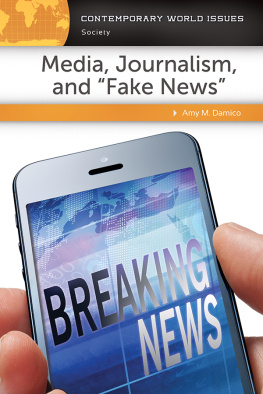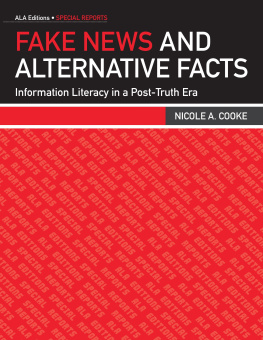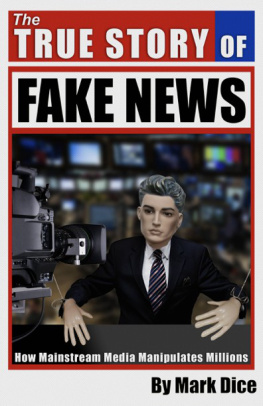
Fake News,Propaganda, andPlain Old Lies
Fake News,Propaganda, andPlain Old LiesHow to Find TrustworthyInformation in the Digital AgeD O N A L D A . B A R C L A YROWMAN & LITTLEFIELD
Lanham Boulder New York London
Published by Rowman & LittlefieldAn imprint of The Rowman & Littlefield Publishing Group, Inc.4501 Forbes Boulevard, Suite 200, Lanham, Maryland 20706www.rowman.comUnit A, Whitacre Mews, 26-34 Stannary Street, London SE11 4ABCopyright 2018 by The Rowman & Littlefield Publishing Group, Inc.
All rights reserved. No part of this book may be reproduced in any form or by anyelectronic or mechanical means, including information storage and retrieval systems,without written permission from the publisher, except by a reviewer who may quotepassages in a review.British Library Cataloguing in Publication Information Available
Library of Congress Cataloging-in-Publication DataNames: Barclay, Donald A. author.Title: Fake news, propaganda, and plain old lies : how to find trustworthyinformation in the digital age / Donald A. Barclay.Description: Lanham : Rowman & Littlefield, 2018. | Includes bibliographicalreferences and index.Identifiers: LCCN 2017051583 (print) | LCCN 2017053314 (ebook) | ISBN9781538108901 (electronic) | ISBN 9781538108895 (hardback : alk. paper)Subjects: LCSH: Fake news. | JournalismHistory21st century. | Onlinejournalism.Classification: LCC PN4784.F27 (ebook) | LCC PN4784.F27 B37 2018 (print) |DDC 070.4/3dc23LC record available at https://lccn.loc.gov/2017051583The paper used in this publication meets the minimum requirements ofAmerican National Standard for Information SciencesPermanence of Paperfor Printed Library Materials, ANSI/NISO Z39.48-1992.Printed in the United States of America
To my lovely family:Alexandra, Emily, Tess, and Caroline.Love to you all.
Contents
Preface ix
Acknowledgments xv Credible Information: Why It Matters, What Are Its Limitations1 Fake News as Phenomenon: (Almost) Nothing New underthe Sun29 Tricks of the Trade: Techniques That Lower YourInformation Guard57 Logical Fallacies: More Tools of Deception91 Evaluating an Information Source: Nine EssentialQuestions Everyone Should Ask101 Power in Numbers: Negotiating the Statistics Minefield117 Scholarly Information: Identifying, Evaluating, andUnderstanding It147 Help Is Where You Find It: Resources for Evaluating Information181
Final Thoughts 195
Notes 199
Index 213
About the Author 227vii
Preface
WHY READ A BOOK BY A LIBRARIAN?As a topic of debate and discussion, fake news really blew up during thehomestretch of the 2016 US presidential election. A search of the
New YorkTimes database from July 1, 2016, to December 31, 2016, turns up 319 articlesin which the phrase
fake news appears. An identical search covering the sametime span turns up 151 such articles in the
Wall Street Journal. Tallying up thenumber of social media posts about fake news during the last half of 2016 isimpossible, but all the evidence points to the fact that the topic was as big onsocial media as it was in the traditional news media. And remains so.At the time when now-familiar phrases such as
fake news and
alternativefacts started regularly appearing in the media (social and news), at least partof the population reacted with surprise if not shock. For me, however, thestories about fake news came as no surprise. As someone who has workedas an academic librarian since 1990 (and who, prior to that, spent four yearsteaching research-based college writing), teaching people to think criticallyabout how they evaluate, internalize, and apply information has been a majorpart of my job for most of my working life. Information literacy is somethingI have pondered, studied, practiced, and written about for going on threedecades.For those not familiar with the jargon of the library profession,
informa-tion literacy (a phrase that was coined in 1974)1 describes the efforts of librar-ians to help people think critically about what they read, hear, and see. Ofix
x
P R E F A C Ecourse, even before the phrase
information literacy entered the professionallexicon, librarians were actively engaged in teaching people how to negotiateincreasingly complex information environments. Evidence exists of libraryinstruction dating back to the 1820s at Harvard University.2 Courses on usinglibraries emerged at a number of colleges and universities after the Civil War.Until well into the twentieth century, however, librarians largely focusedtheir instructional efforts on giving tours of library buildings and teachingthe use of the local card catalog. Beginning in the 1960s, the role of librariansin instruction was broadened due to such factors as increases in the sheersize of library collections; the emergence of such technologies as microfilm,photocopiers, and classroom projection; and new educational emphases onactive-learning techniques like self-directed learning and group participation.Rather than teaching people how to locate items in a given library, practitio-ners of information literacy recognized that all learners must be equippedwith the transferable skills required to identify, organize, and cite informa-tion. Even more importantly, information literacy embraced teaching peoplehow to critically evaluate the credibility and appropriateness of informationsources; as it turns out, information literacy has always been about teachingthe very skills a person needs to navigate todays complex information land-scape, a landscape that includes wide swaths of fake news.In the digital world, information literacy is a far more complex subjectthan in those times when almost all information came in a physical package ofone form or another. Before the web really caught on in the mid to late 1990s,the average persons hunting ground for information was located entirely inthe nondigital world and, by the standards of the twenty-first century, wasrather limited: subscriptions to a local newspaper and perhaps a handful ofnational magazines, whatever books were included in ones personal library,the content of television and radio broadcasts, plus the collections of thenearest academic or public libraries. In so limited a universe of information,achieving information literacywhile still a challengewas less dauntingthan it is in a digital world where information overload is the one constant,and the old standards of objectivity and factuality seem to have been tossedinto the same waste bin containing the pay phone and the foldable road map.Anyone who wishes to make sense of so crowded and chaotic a landscapewould do well to seek out a seasoned guide. Perhaps a guide like me: an infor-mation professional who started his career in a nondigital world, transitioned
P R E F A C Exito the digital world, and has devoted thousands of hours to helping peoplelike you become independent, information-literate thinkers.
THE IMPACT OF FAKE NEWS ON INFORMATION LITERACYAs a librarian and an author, I see the explosion of interest in fake news asboth a blessing and a curse. The blessing is that the interest in fake news hascreated a great opportunity for teaching people to become more informationliterate. Historically, schools and colleges have treated information literacy assomething of an orphan subject, never providing it with the type of perma-nent administrative home enjoyed by service courses like freshman writing orintroductory mathematics. As the domain of librarians rather than teachingfaculty, full-fledged courses in information literacy have been few; instead, in-formation literacy was something for the librarians to cover during a fifty-minute visit with a freshman writing course full of unmotivated students,most of whom did not understand that what the librarian was yakking abouthad the potential to improve both their grades and their lives. Since fake news(the topic) started making headlines, however, the situation has improved,with interest in information literacy hitting new highs.3 Colleges and univer-sities are suddenly offering courses on fake news, including for-credit coursestaught by nonlibrarian faculty. Outside of educational institutions, ordinarypeople are seeking guidance on how to sort out trustworthy information fromthe torrent of unreliable chatter. Truth is, this book would not exist if the fakenews phenomenon had not created a demand that the publisher of this bookbelieves will translate into sales and profits.The fake news phenomenon is also, in some ways, a curse. For one thing,fake news becamealmost instantlyan extraordinarily politicized termwith multiple meanings. This makes approaching fake news from anythinglike an objective point of view almost impossible. In January 2017 I publishedwhat I intended to be a fairly objective article on the topic of fake news only toimmediately see comments accusing me of political bias.4 Perhaps the worstoutcome of the fake news phenomenon would be if all the sound and fury sur-rounding it turns out to be nothing more than a flavor-of-the-month moralpanic that is forgotten as soon as the world turns its attention to the nextcause or crisis to come barreling down the path. What would be most unfor-tunate about such an outcome is that the need to be information literate isnot going away just because the hubbub over fake news happens to fade. The
Next page











